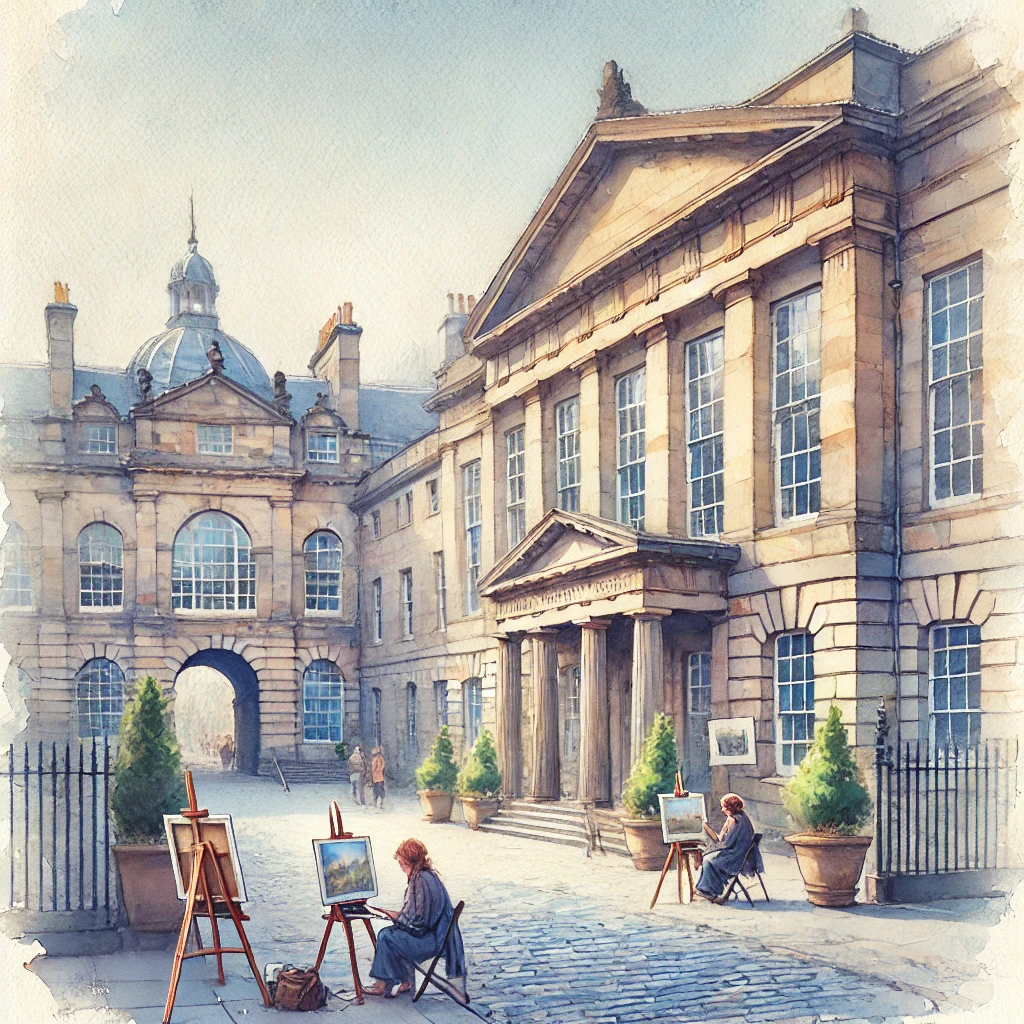
Edinburgh College of Art (ECA) has a long and distinguished history that dates back to its founding in 1760 as the Trustees’ Academy. Established to promote the study of fine arts in Scotland, the institution was initially backed by the Board of Trustees for Fisheries, Manufactures, and Improvements in Scotland. This initiative was meant to support the Scottish Enlightenment, which emphasized the value of education and artistic refinement. Over time, the academy evolved, eventually leading to the formation of the Edinburgh College of Art in 1906.
The newly formed Edinburgh College of Art emerged as a response to the growing need for a formalized art education institution in Scotland. With increasing industrialization, there was a desire to cultivate artistic talent that could contribute to the broader cultural and economic landscape. The institution was designed to offer a structured and comprehensive program in fine arts, architecture, and design. From its earliest days, it set itself apart with its focus on traditional artistic skills while embracing innovative teaching methods.
In its formative years, the college was housed in various locations before settling into its renowned Lauriston Place building in 1909. This move provided a permanent home for the school and allowed for the development of specialized art studios, lecture halls, and exhibition spaces. The striking neo-classical building, designed by John Wilson, remains one of the most iconic structures associated with the college. Its impressive facade and grand interiors have inspired generations of artists, architects, and designers who have passed through its doors.
Throughout the early 20th century, the college established itself as a leader in art education, fostering both national and international talent. The institution gained recognition for its rigorous academic standards and emphasis on a well-rounded artistic education. Its reputation attracted students from across the United Kingdom and beyond, setting the stage for Edinburgh College of Art to become one of Europe’s premier art schools.
Academic Programs and Specializations
Edinburgh College of Art offers a diverse range of academic programs, encompassing fine arts, design, architecture, and digital media. The institution prides itself on delivering a curriculum that balances classical training with modern techniques, ensuring students are well-prepared for contemporary artistic challenges. Courses in painting, sculpture, and printmaking are taught alongside digital arts, animation, and film production. This blend of traditional and modern disciplines has helped ECA remain at the forefront of art education.
One of the most prestigious programs at ECA is its fine art degree, which allows students to specialize in various mediums. The college provides state-of-the-art studios where students can develop their skills and refine their creative voices. The painting department, in particular, has gained a reputation for producing groundbreaking contemporary artists who have made significant contributions to the global art scene. Similarly, the sculpture department continues to push the boundaries of three-dimensional art, encouraging experimentation and innovation.
Architecture is another key area of study at Edinburgh College of Art, with the school offering one of the most respected architecture programs in the UK. Students engage in rigorous training that blends artistic vision with technical proficiency, preparing them for careers in design, urban planning, and sustainable architecture. The program benefits from its affiliation with the University of Edinburgh, allowing for interdisciplinary collaboration and research opportunities. Many graduates have gone on to design some of Scotland’s most well-known buildings, further cementing ECA’s influence in the architectural world.
Beyond traditional art disciplines, ECA has expanded its offerings to include programs in film, television, and digital media. These courses cater to the growing demand for skilled professionals in the entertainment industry. Students gain hands-on experience with cutting-edge technology and collaborate on projects that mimic real-world production environments. This adaptability ensures that graduates are not only creatively fulfilled but also equipped with practical skills that make them competitive in the job market.
Notable Alumni and Their Contributions
Edinburgh College of Art has produced an impressive roster of alumni who have left an indelible mark on the world of art, design, and architecture. Among the most notable graduates is Sir William Gillies, a painter renowned for his landscape and still-life compositions. His work has been widely celebrated and remains influential in the Scottish art scene. Another distinguished alumnus is John Bellany, a painter known for his emotionally charged and vividly colored depictions of Scottish life. His contributions helped redefine contemporary Scottish art, earning him international recognition.
In the realm of design, ECA alumni have also made significant contributions. Barbara Rae, an acclaimed painter and printmaker, has gained recognition for her bold use of color and abstract compositions. Her work is held in major collections worldwide, including the British Museum and the National Gallery of Scotland. Meanwhile, Eduardo Paolozzi, a pioneer of the pop art movement, also studied at ECA before going on to influence modern art through his innovative sculptures and collages. His legacy continues to inspire artists and designers alike.
The field of architecture has also seen ECA graduates rise to prominence. Sir Basil Spence, the architect behind Coventry Cathedral, trained at the college and went on to become one of the most influential architects of the 20th century. His work on public buildings and cultural institutions has shaped modern architecture in Britain and beyond. Similarly, Richard Murphy, another ECA-trained architect, has made a name for himself with his innovative residential and public projects that seamlessly blend contemporary aesthetics with functional design.
Filmmakers and digital artists have also emerged from ECA, further demonstrating the school’s far-reaching impact. Tilda Swinton, although primarily known as an actress, studied at ECA and has collaborated with some of the most innovative filmmakers of her generation. Her unconventional approach to acting and storytelling reflects the creative spirit of the institution. These alumni, along with countless others, underscore the enduring legacy of Edinburgh College of Art as a breeding ground for artistic excellence.
The Influence of Edinburgh College of Art on Scotland’s Cultural Scene
Edinburgh College of Art (ECA) has played a central role in shaping Scotland’s cultural landscape, influencing both the visual arts and the broader creative industries. The college has long been a hub for artistic movements, fostering an environment where new ideas are explored and developed. Many of its students have gone on to become key figures in Scottish art, leaving behind a legacy that continues to inspire future generations. The influence of ECA extends beyond the classroom, as it has actively contributed to Scotland’s cultural identity through exhibitions, public art, and collaborations with major institutions.
One of the most significant ways ECA has impacted Scottish culture is through its connection to the Edinburgh Festival Fringe. The annual event, which is the world’s largest arts festival, provides a platform for emerging talent, many of whom have roots at ECA. The college has often hosted exhibitions and performances in conjunction with the festival, giving students a direct avenue to showcase their work to an international audience. This integration of education and real-world exposure has helped solidify ECA as a cornerstone of Scotland’s artistic scene.
ECA has also played a role in public art initiatives, with many of its faculty and alumni involved in projects that bring creativity into everyday life. Public sculptures, murals, and installations across Edinburgh and beyond bear the mark of ECA-trained artists. Eduardo Paolozzi’s sculptures, for example, can be seen in prominent locations such as London’s Tottenham Court Road Station, demonstrating the far-reaching impact of the college’s graduates. These contributions not only beautify urban spaces but also foster a deeper appreciation for contemporary art in the public sphere.
Moreover, the college has been instrumental in maintaining Scotland’s artistic heritage while pushing the boundaries of modern creativity. Its strong ties with institutions such as the Scottish National Gallery and the National Museum of Scotland allow for ongoing research and collaboration. Through these partnerships, ECA students and faculty have helped curate exhibitions, restore historical artworks, and engage with Scotland’s rich artistic traditions. This dual focus on preservation and innovation ensures that ECA continues to be a driving force in Scotland’s cultural evolution.
The Merger with the University of Edinburgh
In 2011, Edinburgh College of Art underwent a significant transformation when it merged with the University of Edinburgh. This decision was driven by the need to enhance resources, expand interdisciplinary opportunities, and secure the college’s long-term future. By joining forces with one of the UK’s top universities, ECA gained access to greater funding, research capabilities, and global academic networks. The merger was met with mixed reactions at the time, but in the years since, it has proven to be a beneficial step for the institution.
One of the primary advantages of the merger has been the integration of ECA’s artistic expertise with the university’s research strengths. This has led to new programs that bridge the gap between art, science, and technology. For example, the digital design and animation courses now incorporate cutting-edge research in artificial intelligence and virtual reality. Architecture students have also benefited from expanded resources, including access to advanced engineering and sustainability studies. These interdisciplinary collaborations have positioned ECA at the forefront of creative innovation.
The merger also allowed ECA students to take advantage of the University of Edinburgh’s extensive academic resources. Students now have access to one of the largest libraries in the UK, as well as specialized archives and research facilities. This has greatly enriched the learning experience, providing students with a broader intellectual foundation to support their artistic endeavors. Additionally, being part of a world-renowned university has increased the prestige of ECA’s degrees, making graduates more competitive in international job markets.
Despite the benefits, the merger also came with challenges, including concerns about maintaining the distinct identity of ECA. Some feared that the college’s unique artistic culture would be diluted within the larger university structure. However, ECA has maintained its creative independence by preserving its specialized studios, faculty, and teaching methodologies. While administrative aspects have been integrated into the university, the artistic spirit of ECA remains intact, ensuring that it continues to thrive as a leading institution for art education.
International Influence and Global Collaborations
Edinburgh College of Art has established itself as a globally recognized institution, attracting students, faculty, and collaborators from around the world. Its reputation for excellence has led to partnerships with some of the most prestigious art schools and universities internationally. These collaborations provide students with exchange programs, joint projects, and exposure to diverse artistic traditions. This global engagement has helped ECA maintain its relevance in an increasingly interconnected world.
One of the most notable international collaborations is ECA’s relationship with institutions in the United States, such as the Rhode Island School of Design and the School of the Art Institute of Chicago. These partnerships allow students to study abroad, experiencing different artistic methodologies and cultural perspectives. Such exchanges have enriched the learning environment at ECA, fostering cross-cultural creativity and networking opportunities that last well beyond graduation. Many ECA alumni have leveraged these experiences to build successful international careers.
ECA has also played a key role in art and design research on a global scale. Faculty members have participated in international symposiums, art biennales, and academic conferences, sharing their expertise with the global art community. The college has been involved in projects ranging from sustainable urban design initiatives in Europe to digital media collaborations with institutions in Asia. These efforts have reinforced ECA’s standing as a leader in contemporary art education, influencing artistic and academic circles worldwide.
Additionally, ECA has attracted a diverse student body, with a significant number of international students enrolling in its programs each year. This cultural diversity enriches the artistic dialogue on campus, allowing students to learn from a wide range of perspectives. The presence of international artists and scholars also enhances the vibrancy of ECA’s exhibitions, workshops, and creative projects. By fostering a truly global learning environment, ECA ensures that its graduates are well-prepared to navigate the complexities of the modern art world.
The Future of Edinburgh College of Art
As Edinburgh College of Art looks to the future, it continues to evolve while staying true to its core mission of fostering artistic excellence. The rise of digital technology, environmental sustainability, and interdisciplinary collaboration are shaping the next phase of ECA’s development. The college has embraced these changes, ensuring that its programs remain at the cutting edge of contemporary art and design. By continually adapting to new creative challenges, ECA maintains its status as one of the world’s premier art institutions.
One major focus for ECA’s future is the integration of technology into artistic practice. Digital art, virtual reality, and artificial intelligence are becoming increasingly important in creative industries. To stay ahead of these trends, ECA has invested in new facilities that support digital innovation. Programs in game design, 3D modeling, and interactive media are being expanded, allowing students to explore new artistic frontiers. These advancements ensure that ECA graduates remain competitive in an ever-changing digital landscape.
Sustainability is another key priority for ECA moving forward. The college is incorporating eco-friendly design principles into its architecture and urban planning programs, encouraging students to create environmentally responsible works. Studios are also adopting sustainable practices, such as using recycled materials and reducing waste. These initiatives reflect a growing awareness of the role art and design can play in addressing global environmental challenges. By preparing students to think sustainably, ECA is contributing to a greener future.
Ultimately, the future of Edinburgh College of Art is built on a foundation of creativity, innovation, and global engagement. As it continues to adapt to new artistic and technological landscapes, the institution remains committed to nurturing the next generation of artists, designers, and architects. Whether through traditional fine arts or cutting-edge digital media, ECA will continue to shape the future of the creative industries. With a rich history behind it and an exciting future ahead, the legacy of Edinburgh College of Art is set to endure for generations to come.
Key Takeaways
- ECA has played a major role in shaping Scotland’s cultural scene through exhibitions, public art, and partnerships.
- The 2011 merger with the University of Edinburgh provided access to more resources and interdisciplinary opportunities.
- ECA maintains strong international connections, fostering global collaborations and study-abroad programs.
- The college is embracing new technologies, such as virtual reality and artificial intelligence, in its curriculum.
- Sustainability and environmental consciousness are key focuses for ECA’s future programs and initiatives.
FAQs
1. How has ECA influenced Scotland’s culture?
ECA has contributed through public art, collaborations with institutions, and its role in major festivals like the Edinburgh Festival Fringe.
2. What was the impact of ECA’s merger with the University of Edinburgh?
The merger provided access to more funding, research opportunities, and global academic networks while maintaining ECA’s creative independence.
3. What global partnerships does ECA have?
ECA collaborates with institutions such as the Rhode Island School of Design and participates in international research projects.
4. How is ECA incorporating technology into its programs?
The college is expanding programs in digital art, game design, and virtual reality to prepare students for emerging creative fields.
5. What sustainability efforts is ECA undertaking?
ECA promotes eco-friendly design principles, sustainable materials, and environmental awareness in its curriculum.




